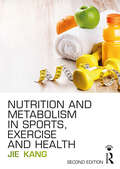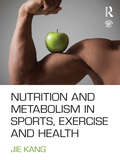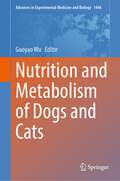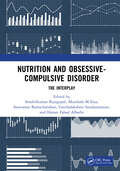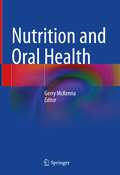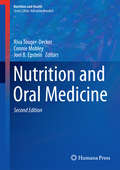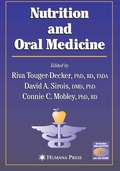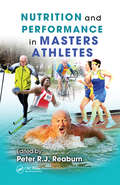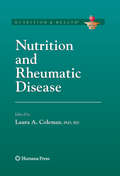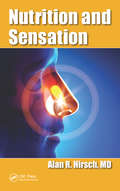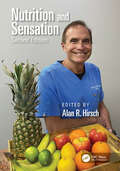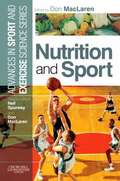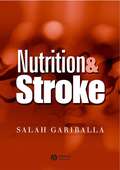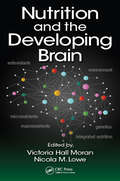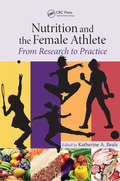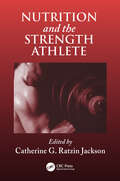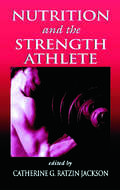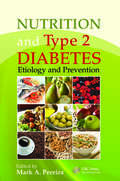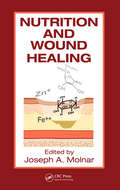- Table View
- List View
Nutrition and Metabolism in Sports, Exercise and Health
by Jie KangThe second edition of Nutrition and Metabolism in Sports, Exercise and Health offers a clear and comprehensive introduction to sport and exercise nutrition, integrating key nutritional facts, concepts and dietary guidelines with a thorough discussion of the fundamental biological science underpinning physiological and metabolic processes. Informed by the latest research in this fast-moving discipline, the book includes brand-new sections on, amongst others: • Cellular structure for metabolism • Alcohol and metabolism • Uncoupling protein and thermogenesis • Dietary guidelines from around the world • Nutrient timing • Protein synthesis and muscle hypertrophy • Protein supplementation • Ergogenic effects of selected stimulants • Nutritional considerations for special populations • Dehydration and exercise performance Each chapter includes updated pedagogical features, including definitions of key terms, chapter summaries, case studies, review questions and suggested readings. A revised and expanded companion website offers additional teaching and learning features, such as PowerPoint slides, multiple-choice question banks and web links. No book goes further in explaining how nutrients function within our biological system, helping students to develop a better understanding of the underlying mechanisms and offering the best grounding in applying knowledge to practice in both improving athletic performance and preventing disease. As such, Nutrition and Metabolism in Sports, Exercise and Health is essential reading for all students of sport and exercise science, kinesiology, physical therapy, strength and conditioning, nutrition or health sciences.
Nutrition And Metabolism In Sports, Exercise And Health (PDF)
by Jie KangA key determinant of successful athletic performance is the high-level energy transformation which begins with combustion of the food that we eat. By developing a sound understanding of good nutrition we can improve athletic performance, help maintain good health and prevent disease. This clear and comprehensive introduction to nutrition in sport, exercise and health goes further than any other textbook in integrating key nutritional facts, concepts and dietary guidelines with a thorough discussion of the fundamental biological science underpinning our physiological and metabolic processes. By clearly explaining how nutrients function within our biological system, the book helps students to develop a better understanding of the underlying mechanisms, which, in turn, will help the student to apply their knowledge in practice. The book includes in depth discussion of key contemporary topics within nutrition including: nutrient bioenergetics nutrition and metabolic disease nutritional ergogenic aids nutrition for special populations nutritional assessment. Each chapter includes useful pedagogical features, including case studies, review questions, definitions of key terms, and practical laboratory exercises #65533; such as techniques for assessing nutritional status, body composition and physical activity patterns. A companion website offers additional teaching and learning features, such as PowerPoint slides, multiple-choice question banks and web links. As the most up-to-date introduction to sport and exercise nutrition currently available, this book is essential reading for all students of sport and exercise science, kinesiology, physical therapy, nutrition, dietetics or health sciences. Visit the companion website at www. routledge. com/cw/kang
Nutrition and Metabolism of Dogs and Cats (Advances in Experimental Medicine and Biology #1446)
by Guoyao WuThis book provides new knowledge about the nutrition and metabolism, as well as the roles of nutrients in the immunity, health, and management of companion animals (dogs and cats). The domestic dog (facultative carnivore) and the domestic cat (obligate carnivore) have evolved differentially in their digestive tract, nutrition, metabolism, chemical sensing, and feeding behavior. These animals have been human companions for at least 12,000 and 9,000 years, respectively, and continue to contribute to the mental health and well-being of children, adolescents, and adults. Both dogs and cats have become increasingly popular in many countries and worldwide over the past decades. Comprehensive update about how the animals utilize dietary nutrients for optimum growth, development, and health is beneficial for their owners, as well as students and researchers. Chapter 4: Characteristics of Nutrition and Metabolism in Dogs and Cats is available open access under a Creative Commons Attribution 4.0 International License
Nutrition and Obsessive-Compulsive Disorder: The Interplay
by Hanan Fahad Alharbi Senthilkumar Rajagopal M. Mohamed Essa Saravanan Ramachandran Geethalakshmi SundararamanThis reference book discusses the role of nutrition in obsessive-compulsive disorders (OCD). It covers the investigational therapies in OCD, use of animal models, and biomarkers for better diagnosis, monitoring, and possible therapeutic options with nutrients for patients with OCD. This book highlights the role of probiotics, amino acids, vitamins, micronutrients, and salts in the management of OCD. It includes such topics as applications of computational modeling and nano-biotechnology in OCD, the effects of environmental pollutants, and the regulation of antidepressants in OCD.KEY FEATURES Covers emerging therapeutic and nutritional approaches for the treatment and management of OCD Reviews the role of various micronutrients in OCD Discusses the prenatal genetic diagnosis and application of computational modelling in OCD Includes the nutritional and dietary roles in such neuropsychiatric disorders as depression and obsessive-compulsive disorder (OCD) Explores the application of nano-biotechnology in OCD This book is meant for researchers and professionals in the field of nutritional neuroscience and psychology
Nutrition and Obsessive-Compulsive Disorder: The Interplay
by Senthilkumar Rajagopal Musthafa M Essa Saravanan Ramachandran Geethalakshmi Sundararaman Hanan Fahad AlharbiThis reference book discusses the role of nutrition in obsessive-compulsive disorders (OCD). It covers the investigational therapies in OCD, use of animal models, and biomarkers for better diagnosis, monitoring, and possible therapeutic options with nutrients for patients with OCD. This book highlights the role of probiotics, amino acids, vitamins, micronutrients, and salts in the management of OCD. It includes such topics as applications of computational modeling and nano-biotechnology in OCD, the effects of environmental pollutants, and the regulation of antidepressants in OCD.KEY FEATURES Covers emerging therapeutic and nutritional approaches for the treatment and management of OCD Reviews the role of various micronutrients in OCD Discusses the prenatal genetic diagnosis and application of computational modelling in OCD Includes the nutritional and dietary roles in such neuropsychiatric disorders as depression and obsessive-compulsive disorder (OCD) Explores the application of nano-biotechnology in OCD This book is meant for researchers and professionals in the field of nutritional neuroscience and psychology
Nutrition and Oral Health
by Gerry McKennaThis book explores in depth the relationships between nutrition and oral health. Oral health is an integral part of general health across the life course, and this book examines nutritional and oral health considerations from childhood through to old age, with particular attention focused on the consequences of demographic changes. Current knowledge on the consequences of poor diet for the development and integrity of the oral cavity, tooth loss, and the progression of oral diseases is thoroughly reviewed. Likewise, the importance of maintenance of a disease-free and functional dentition for nutritional well-being at all stages of life is explained. Evidence regarding the impact of oral rehabilitation on nutritional status is evaluated, and strategies for changing dietary behaviour in order to promote oral health are described. Nutrition and Oral Health will be an ideal source of information for all who are seeking a clearly written update on the subject.
Nutrition and Oral Medicine (Nutrition and Health)
by Riva Touger-Decker Connie Mobley Joel B. EpsteinThis second edition addresses the complex, multifaceted relationships between nutrition and oral health, explores proposed relationships between oral, systemic and nutritional well-being and provides insights into interprofessional, comprehensive care for individuals. Chapters focus on diet, nutrition and oral health promotion and disease prevention across the lifespan, oral and dental diseases and disorders, oral manifestations of systemic diseases, and discussions of the synergy between oral tissues and nutrients. Cutting edge research issues regarding the relationship of individual antioxidants, trace elements, polyphenols and other nutrient substrates and oral health/disease, nutrigenomics, screening for nutrition and oral risk and other areas are covered in detail. Editors and authors include experts in nutrition and oral health from around the world. This second edition is a invaluable resource for health professionals in the fields of nutrition and dentistry as well as other disciplines whose research, practice and education includes nutrition and oral medicine. It is an excellent resource for graduate level nutrition and dental students, dental and nutrition practitioners, educators and researchers as well as other health professionals.
Nutrition and Oral Medicine (Nutrition and Health)
by Riva Touger-Decker David A. Sirois Connie MobleyBenchmark studies by internationally recognized leaders in dentistry and nutrition review the many links connecting nutrition and dietary practices to oral diseases and disorders. The authors examine the effects of diet and its nutrient components on the development, growth, maintenance, prevention, and treatment of diseases in the oral cavity. Topics range from the relation between oral and general health, nutrition/diet and systemic health, and nutrition/diet and oral health, to select oral and systemic diseases with known nutrition and oral health interfaces; also cutting-edge research issues regarding the relationship of individual anioxidants, trace elements, polyphenols, and other nutrient substrates.
Nutrition and Performance in Masters Athletes
by Peter ReaburnAddresses the Aging Process and Its Effect on Sports PerformanceAge-related changes influence all physiological systems, including those used during exercise and sport. Highlighting masters athletes-older adults who train and compete in organized sports-Nutrition and Performance in Masters Athletes examines the extent to which regular physical trai
Nutrition and Psychiatric Disorders: An Evidence-Based Approach to Understanding the Diet-Brain Connection (Nutritional Neurosciences)
by Firas Kobeissy Wael MohamedThe book explores the intricate relationship between nutrition, brain function, and psychiatric disorders. The first section of the book delves into the neurobiological aspects of psychiatric disorders, including the neuroanatomy, neuropathology, biochemical and neuropharmacology factors that play a role in the development of these disorders. It also discusses the impact of human nutrition on brain function and the implications of nutrition and metabolism on psychological functioning. The next section focuses on the diet-brain connection, exploring nutritional psychiatry and the current state of evidence, the role of the microbiome, and the effects of certain foods such as chocolate and coffee on mood and mood disorders. The chapters also examine the impact of diet on mental health and cognition across the lifespan and provides a case study of the relationship between diet and psychological health. In the final section, the book delves into the nutritional treatment of psychiatric disorders, including the psychopharmacology of psychiatric disorders and food intake, and multidisciplinary approaches to psychiatric treatment.. Overall, this book offers a comprehensive and evidence-based examination of the complex relationship between nutrition, brain function, and psychiatric disorders, and provides a foundation for further research and development of effective nutritional interventions for the treatment of these disorders.
Nutrition and Rheumatic Disease (Nutrition and Health)
by Laura A. Coleman R. RoubenoffIn this book, experts provide a comprehensive review of current knowledge regarding nutrition and dietary management for the complex set of rheumatic conditions. Within the disease-specific chapters, the authors present a historical perspective, a discussion of the major clinical features, current management and treatment, a review of the literature related to nutritional status and diet, and dietary recommendations, based on current scientific evidence. The field of rheumatic diseases includes a wide variety of pathologic processes. This book will greatly benefit physicians specializing in internal medicine, family practice, and rheumatology.
Nutrition and Sensation
by Alan R. HirschNutrition and Sensation explores how sensations can impact nutrition. It unravels the hidden sensory universe acting to control our appetite and nutritional desires. The sensory influence on food choice is ubiquitous. Whether it is the color of soda, the viscosity of maple syrup, or the aroma of chocolate, the sensory experience fuels consumption.T
Nutrition and Sensation
by Alan R. HirschNutrition and Sensation, Second Edition continues to explore how sensations unravel the hidden sensory universe which acts to control our appetite and nutritional desires. The sensory influence on food is found everywhere – whether it is the color of soda, the viscosity of maple syrup, or the aroma of chocolate – the sensory experience fuels consumption. This book continues to discuss the impact of olfaction, gustation, retronasal olfaction, vision, vestibular function, hearing, and somatosensory and tactile nature on nutrition. It also focuses on the use of the sensory system to treat nutritional disorders including obesity, with attention to the mechanisms encompassing smell and taste and how this can influence satiety and weight. Nutrition and Sensation, Second Edition provides a deeper understanding of the fascinating link between the sensory system and nutrition.
Nutrition and Sensation
by Alan R. HirschNutrition and Sensation, Second Edition continues to explore how sensations unravel the hidden sensory universe which acts to control our appetite and nutritional desires. The sensory influence on food is found everywhere – whether it is the color of soda, the viscosity of maple syrup, or the aroma of chocolate – the sensory experience fuels consumption. This book continues to discuss the impact of olfaction, gustation, retronasal olfaction, vision, vestibular function, hearing, and somatosensory and tactile nature on nutrition. It also focuses on the use of the sensory system to treat nutritional disorders including obesity, with attention to the mechanisms encompassing smell and taste and how this can influence satiety and weight. Nutrition and Sensation, Second Edition provides a deeper understanding of the fascinating link between the sensory system and nutrition.
Nutrition And Sport (Advances In Sport And Exercise Science Ser. (PDF))
by Don MacLaren Neil SpurwayPart of the Advances in Sport and Exercise Science series, the textbook 'Nutrition and Sport' focuses on the key areas endemic to any sports nutrition programme.
Nutrition and Stroke: Prevention and Treatment
by Salah GariballaStroke is a common and devasting event, which often results in death or major loss of independence, with immense human and financial costs. In the developed world stroke accounts for around 10 per cent of all deaths and is the most important single cause of severe disability among western people living in their own homes. Futhermore, in the next 30 years, the burden of stroke will grow substantially in most developing nations. There is now substantial evidence that dietary habits not only influence the prevalence of stroke, but also its course and outcome once it has occurred. The author, Salah Gariballa, who has many years’ experience working in this area, carefully presents and reviews this information in a user-friendly and accessible manner. The book is divided into three major sections. Section I covers nutrition and ageing and includes chapters on the challenge of stroke, ageing changes and nutrition, macro- and micronutrient intake in elderly people and the diagnosis of protein-energy undernutrition. Section II deals with nutritional factors and the risk of stroke, and includes details of the role of dietary and nutritional factors in stroke prevention, antioxidants and risk from ischaemic stroke, homocysteine and endothelial dysfunction. The final section of the book covers nutrition factors following stroke, including cerebral ischaemia, protein-energy undernutrition and the nutritional status and support of stroke and special stroke patients. A final chapter looks at probable future directions, including important recommendations. Nutrition and stroke is essential reading for nutritionists, dietitians and many other groups of health professionals, including general practitioners, gerontologists, occupational therapists and nursing staff. Personnel in pharmaceutical and food companies involved in the formulation of dietary supplements and nutraceuticals will find much of interest within the book’s covers. Those dealing with the prevention and treatment of stroke around the world should read this book, and copies should be available in libraries of universities and medical schools worldwide.
Nutrition and Supplements in Cycling
by Lewis A. Gough S. Andy SparksNutrition and Supplements in Cycling provides a blueprint for all the key nutritional aspects a cyclist should consider from health to macro- and micro-nutrients, and the finer details, such as sports supplements to improve competitive performance. As a result, cyclists and coaches can use this book as a handbook to help with supporting their own (or their athletes') health and performance through evidence-based nutrition.The nutritional demands of cycling are as diverse as the number of disciplines in the sport. To address this issue, this book covers the nutritional strategies for short- and long-distance disciplines and considers the implications of training and racing in a variety of environmental conditions. The book is divided into two distinct parts that are structured around the nutrition demands and practices of cyclists and an evaluation of novel and existing supplements that are currently being used or considered by riders.This book represents a go-to resource for cyclists, performance nutritionists, coaches, and students looking for the most effective and up-to-date evidence-based nutritional strategies for enhancing cycling performance. It brings together a team of emerging and world-leading academics, along with practitioners and riders from the UCI World and Pro Tours, to provide insightful evaluations of the latest science and to translate that knowledge into practical recommendations. Finally, it presents a model of reflective practice designed to enhance the performance nutrition practitioner’s development and practices. This book is key reading for active cyclists, cycling coaches, and athletes, as well as researchers and students of sport and exercise science, nutrition, human performance, and exercise physiology.
Nutrition and Supplements in Cycling
Nutrition and Supplements in Cycling provides a blueprint for all the key nutritional aspects a cyclist should consider from health to macro- and micro-nutrients, and the finer details, such as sports supplements to improve competitive performance. As a result, cyclists and coaches can use this book as a handbook to help with supporting their own (or their athletes') health and performance through evidence-based nutrition.The nutritional demands of cycling are as diverse as the number of disciplines in the sport. To address this issue, this book covers the nutritional strategies for short- and long-distance disciplines and considers the implications of training and racing in a variety of environmental conditions. The book is divided into two distinct parts that are structured around the nutrition demands and practices of cyclists and an evaluation of novel and existing supplements that are currently being used or considered by riders.This book represents a go-to resource for cyclists, performance nutritionists, coaches, and students looking for the most effective and up-to-date evidence-based nutritional strategies for enhancing cycling performance. It brings together a team of emerging and world-leading academics, along with practitioners and riders from the UCI World and Pro Tours, to provide insightful evaluations of the latest science and to translate that knowledge into practical recommendations. Finally, it presents a model of reflective practice designed to enhance the performance nutrition practitioner’s development and practices. This book is key reading for active cyclists, cycling coaches, and athletes, as well as researchers and students of sport and exercise science, nutrition, human performance, and exercise physiology.
Nutrition and the Developing Brain
by Victoria Hall Moran Nicola M. LoweNutrients play a significant role in brain development throughout fetal and postnatal life. This book reviews the evidence from animal and human research, highlighting the influence of specific nutrients on brain function and cognitive development. With a unique, integrative approach to the nutritional, environmental, and genetic influences on brain development, the book examines issues such as single versus multiple limiting nutrients, critical periods of deficiency, and the impact of the child-parent relationship on the architecture of the developing brain. The effect of undernutrition on the developing brain of infants and young children can be devastating and enduring. It can impede behavioural and cognitive development and educability, thereby undermining future work productivity. Chapter authors are experts in this field of research and provide an up-to-date insight into the role of the individual nutrients in brain development and function.
Nutrition and the Developing Brain
by Victoria Hall Moran Nicola M. LoweNutrients play a significant role in brain development throughout fetal and postnatal life. This book reviews the evidence from animal and human research, highlighting the influence of specific nutrients on brain function and cognitive development. With a unique, integrative approach to the nutritional, environmental, and genetic influences on brain development, the book examines issues such as single versus multiple limiting nutrients, critical periods of deficiency, and the impact of the child-parent relationship on the architecture of the developing brain. The effect of undernutrition on the developing brain of infants and young children can be devastating and enduring. It can impede behavioural and cognitive development and educability, thereby undermining future work productivity. Chapter authors are experts in this field of research and provide an up-to-date insight into the role of the individual nutrients in brain development and function.
Nutrition and the Female Athlete: From Research to Practice
by Katherine A. BealsDesigned to address the nutritional needs of women over the age of 18 who partake in sports on a regular basis, Nutrition and the Female Athlete: From Research to Practice highlights nutritional concerns specific to active women. It discusses the link between nutrition and athletic performance and translates research into practical applications for
Nutrition and the Strength Athlete
by Catherine G. R. JacksonBoth strength training and weight training are recognized by the American College of Sports Medicine as vital to a high quality of life. They are also of tremendous benefit to young, healthy adults and adults with or at risk for osteoporosis. Most information on nutrition and strength athletes, however, is scattered throughout pamphlet-type publica
Nutrition and the Strength Athlete
by Catherine G. R. JacksonBoth strength training and weight training are recognized by the American College of Sports Medicine as vital to a high quality of life. They are also of tremendous benefit to young, healthy adults and adults with or at risk for osteoporosis. Most information on nutrition and strength athletes, however, is scattered throughout pamphlet-type publica
Nutrition and Type 2 Diabetes: Etiology and Prevention
by Mark A. PereiraOver the past two decades, type 2 diabetes has emerged as a leading threat to global health, and the considerable overlap in obesity and diabetes trends are likely no coincidence. While the underpinnings for both etiologies are linked to lifestyles, particularly dietary and physical activity patterns, determining optimal approaches for preventing a
Nutrition and Wound Healing
by Joseph A. Molnar FacsWith mounting evidence regarding the role of poor nutrition in the development of chronic diseases such as heart disease and diabetes, it is no secret that appropriate nutrition is crucial to optimal health. Achieving the correct balance of elements provides the body with the ability to adapt to a shifting and often hazardous environment. Never is
